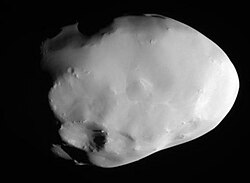 Telesto as seen by the Cassini probe in October 2005 | |
| Discovery | |
|---|---|
| Discovered by | Smith, Reitsema, Larson, Fountain |
| Discovery date | April 8, 1980 |
| Semi-major axis | 294,619 km |
| Eccentricity | 0.000 |
| Orbital period | 1.887802 d[1] |
| Inclination | 1.19° (to Saturn's equator) |
| Satellite of | Saturn |
| Physical characteristics | |
| Dimensions | 29 × 22 × 20 km³ [2] |
| Mean radius | 11.8 ± 1.0 km[2] |
| Rotation period | synchronous |
| Axial tilt | zero |
| Apparent magnitude | 18.7[3] |
| | |
Telesto (pronounced /tɨˈlɛstoʊ/ tə-LES-toe, or as Greek Τελεστώ) is a moon of Saturn. It was discovered by Smith, Reitsema, Larson and Fountain in 1980 from ground-based observations, and was provisionally designated S/1980 S 13.[4] In the following months, several other apparitions were observed: S/1980 S 24[5] S/1980 S 33,[6] and S/1981 S 1.[7]
In 1983 it was officially named after Telesto of Greek mythology.[8] It is also designated as Saturn XIII or Tethys B.
Telesto is co-orbital with Tethys, residing in Tethys' leading Lagrangian point (L4). This relationship was first identified by Seidelmann et al.[9] The moon Calypso also resides in the other (trailing) lagrangian point of Tethys, 60 degrees in the other direction from Tethys.
The Cassini probe performed a distant flyby of Telesto on October 11, 2005. The resulting images show that its surface is surprisingly smooth, devoid of small impact craters.
0 comments:
Post a Comment